In the 1977 Imponderabilia an Example of Performance Art Viewers Participated by
Today Marina Abramović is known as "the grandmother of functioning art," due to her function as a pioneer of the utilize of performance art as a visual arts medium. Abramović began her career in performance in 1973, when she was already in her belatedly twenties. Before that, as a pupil of painting at the Academy of Fine Arts in Belgrade, Abramović explored her interest in the body through paintings influenced by the abstruse forms of Picasso (image one). However, Abramović rapidly found herself frustrated past the limits of expression in painting, and upon her exposure to the operation art medium while at schoolhouse in Zagreb, her works became increasingly immaterial.
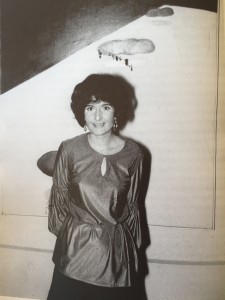

Abramović cites Marcel Duchamp and Dada (image 2), as well equally the Fluxus movement, as being immensely influential on her work. In the 1960s George Maciunas started Fluxus, also directly influenced by Duchamp'due south ready-mades, and Dada performances. Fluxus called for a living art outside the traditional gallery setting.
Fluxus and Dada both advocated art of feel, in which the comprehend of chance, and an accent on audience interaction was crucial towards ridding the globe of the "expressionless" fine art institute in galleries and institutions.
"I have arrived at the conclusion that…the functioning has no pregnant without the public because, as Duchamp said it is the public that completes the work of art. In the example of performance, I would say that public and performer are not merely gratis but almost inseparable."
-Abramović on the influence of Duchamp in her emphasis on audience interaction.
Yoko Ono is one such Fluxus artist who was working in New York in the 1970s, and whose emphasis on the role of the audition, and claiming of passive viewership, is paralleled in Abramović'south Rhythms series of 1973-74. In detail, Ono'southward Cut Piece (1964) (image 3) and Abramović's Rhythm 0 (1974) (epitome 4) emphasize a shared involvement in the use of their ain bodies as victims to chance to enforce active instead of passive viewership.

Since Abramović began her performance career forty years agone, she has go one of the most influential functioning artists in history for her employ of her own torso as both the subject and the medium in performances which test her physical end mental endurance, while also emphasizing audience interaction.
For more data near Dada or Fluxus, follow the links below.
Operation and Torso Fine art in the 1970s:
From the terminate of the 1960s forward, an interest in "body" art emerged, in which both male and female artists turned to the "isolated physical cocky," sacrificing themselves to risky and sad actions every bit a ways to daze their audiences and to challenge commodification of art by museums and galleries. During this period of political and social activism, Marina Abramović, along with Carolee Schneemann, Vito Acconci, Yoko Ono, and other artists, turned to the physical presence of the body in performance and trunk art as an endeavor to jolt the viewer from their traditional role of passivity. Operation through the medium of the torso became a place to admit problems linked to women's bureau, as well as bug of race, sexuality, and otherness. This heightened interest in performance emerged along with the influence of Fluxus, started by George Maciunas in the 1960s, in which artists embraced chance and audition interaction every bit a means to "purge the world of dead fine art."
Duration:
Durational works became increasingly popular in the 1970s for their rejection of traditional authorship or regularity, in directly opposition to the commodity culture related to the gallery or institution. These durational works were continuously in flux and therefore unpredictable and did not fit within a traditional gallery setting. Since the 1970s, Abramović has been a pioneer for the use of performance as a visual fine art form, using the trunk and duration every bit a means to test her mental and concrete limits. In these durational works, such as herRhythms series (1973-74) orLips of Thomas (1975) (video available here), the long periods of time are used to push Abramović'south mental and physical limits, while also challenging the passivity of the viewer, who is made increasingly uncomfortable in watching the artist's own suffering.
For more details, an informative, curtailed overview of performance in the 1960s and 1970s is available on the Walker Fine art Heart'due south website here.
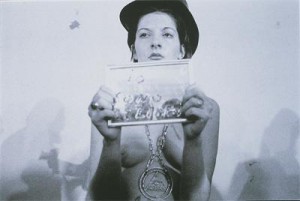
Follow the links below to learn about other major body art and performance artists of the 1960s and 1970s:
Carolee Schneemann:
In Schneemann's 1975 Interior Scroll Schneemann, afterwards applying pigment to her face and body, and enacting a serial of "life model action poses," slowly drew a scroll of paper from her vagina and read aloud from it. By embracing cadre imagery through the presentation of her naked torso, Schneemann rejected the phallus in favor of female sexual empowerment: "Using my body equally an extension of my painting-constructions challenged and threatened the psychic territorial power lines by which women, in 1963, were admitted to the Art Stud Club, and then long as they behaved enough like the men, and did work conspicuously in the traditions and pathways hacked out by men."
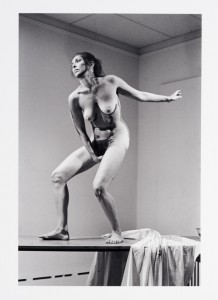
Vito Acconci:
In 1971 Vito Acconci lay hidden under a wooden ramp in New York'southward Sonnabend Gallery, and intermittently masturbated, basing his sexual fantasies off of the sounds of the gallery visitors above him. Acconci expressed these fantasies aloud, where they were then projected through speakers into the gallery space. The piece emphasizes the vital role of the viewer, whose deportment directly influence the development of the work. The visitors are taken out of a role of passivity and instead are unexpectedly objectified past Acconci'south actions beneath the ramp.
Yoko Ono:
Another female person artist who was incorporating the viewer every bit a vital component in performance art in the 1960s and 1970s is Yoko Ono. In 1964 Ono performed Cutting Piece, in which Ono sabbatum passively on a phase, fully clothed, and invited her audition members to mountain the stage and cut off a piece of her clothing using the pair of scissors she placed on the floor beside her. This functioning reflects Ono'due south participation in the Fluxus movement, through her emphasis on audience interaction. The operation is dependent on the actions and reactions of her viewers, and therefore is unpredictable and constantly in flux.
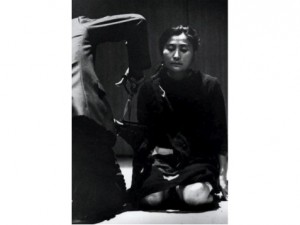
Below is a list of useful links pertaining to the life and works of Marina Abramović, also as near performance and body art in general.
MoMA Lecture Series:The Feminist Future: Marina Abramović:
The following video is from a panel discussion at MoMA about body, sexuality, and gender. Marina Abramović is one of the panelists discussing her ain use of the trunk and sexuality in her performance art. She begins by clarifying that she does not desire to be defined as a feminist artist, or fifty-fifty a woman artist, but just as artist.
http://www.moma.org/explore/multimedia/videos/xvi/166
Art21 on Marina Abramović:
For those interested in learning more about Marina Abramović, Art21 has published a very useful bio and mini-documentary discussing the life and works of Abramović. Y'all tin can notice the full article and video here.
MoMA Explanation of Imponderabilia:
http://world wide web.moma.org/explore/multimedia/audios/190/1974
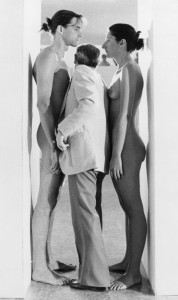
My personal favorite performance past Marina Abramović: Imponderabilia (1977):
In 1976 Abramović met Ulay, and over the next decade they collaborated in a series of relational performances during which they referred to themselves as a collective, androgynous being called "Ulay-Abramović." In these works Abramović and Ulay questioned the socially defined identities of both femininity and masculinity, while besides standing to test their limits. These performances by Abramović and Ulay were not meant to be pleasing glasses, merely rather to disturb the viewer from a role of passivity.
In their 1977 functioning, Imponderabilia, Abramović and Ulay stood as homo doorposts on either side of the narrow entrance to the Galleria Communale d'Arte Moderna, in Bologna, Italy. The narrowness of the space forced visitors to squeeze sideways between them, forced to choose whether to face up the naked Ulay or naked Abramović in gild to enter the museum. Upon viewing the filmed footage from this performance, one notes that what stands out the most in this piece is non the vulnerability of the two naked artists, but rather the vulnerability and uncertainty of the visitors. Each person, upon reaching the archway, was forced to decide first, whether they would enter the museum, and next, whether they would face the naked Abramović or the naked Ulay. By placing these decisions in the hands of the viewer, Imponderabilia becomes a performance of reflection on the subsequent reactions and interactions of the spectators. This piece too reflects Abramović and Ulay'southward shared interest in duration, as the slice was performed in shifts, repeated throughout the exhibition, for a full of 700 hours.

Video of the Imponderabilia operation is bachelor here.
Below is a list of the top ten virtually relevant print and online resources that I have found in researching the life and performance art of Marina Abramović, likewise as well-nigh functioning and torso fine art in general:
- Abramović, Marina, Biesenbach, Klaus, and Museum of Mod Art. Marina Abramović: The Creative person Is Present. New York: Museum of Modern Art, 2010.
This exhibition catalogue was published in conjunction with Marina Abramović's operationThe Artist is Present, held at the Museum of Modernistic Art in 2010. The catalogue includes essays by Principal Curator of Media and Functioning Art, Klaus Biesenbach, as well as four other scholars who analyze Marina Abramović'due south performances through the themes of time, duration, and run a risk. The volume covers over xl years of Abramović's career, from her early sound environments and installations, to her current body art performances.
- Jones, Amelia. Body Fine art/performing the Subject area . Minneapolis: University of Minnesota Printing, 1998.
This book past Amelia Jones is a seminal text about performance and trunk art from the 1960s and 1970s and their influence on the torso fine art of the present. In her discussion, Jones applies feminism, queer theory, psychoanalysis, philosophy, and literary theory in lodge to provide a diverse perspective to the history, influences and goals of body art performances from the 1950s onward.
- Dezeuze, Anna. The 'do-information technology-yourself' Artwork: Participation from Fluxus to New Media. Rethinking Art's Histories. Manchester, Britain: New York: Manchester University Printing; Distributed in the United States by Palgrave Macmillan, 2010.
This anthology by Anna Dezeuze emphasizes the crucial function of the spectator through a word of diverse practices including happenings, installations, and performances from the 1950s to today. These essays provide a thorough historical background to the evolution of functioning art from the 1950s to nowadays, while also discussing theory on viewership and identity. Frazer Ward's essay "Marina Abramović: budgeted zero," and Anna Dezeuze'south essay "Play, Ritual, and Politics: transitional artworks in the 1960s," are particularly useful in their discusses of the themes of Abramović's functioning art, as well as work of other artists in the 1960s and 1970s.
- Westcott, James. When Marina Abramović Dies: A Biography . Cambridge, Mass.: MIT Press, 2010.
This biographical history of Marina Abramović thoroughly covers Abramović's life from her early on beginnings in Yugoslavia; to her increasing success as one of the gimmicky art world's most influential functioning artists. Westcott discusses not only Abramović's seminal performance works, but too thoroughly covers Abramović'south influential beginnings in Yugoslavia from 1946 to 1975, with item interest in her tremulous relationship with her parents.
- Crow, Thomas (1996). The Ascent of the Sixties: American and European art in the era of dissent (Perspectives (Harry N. Abrams, Inc.)). New York, N.Y.: Harry N. Abrams.
This book past Thomas Crow provides an extensive overview of the art and major social and political movements of the 1960s and 1970s both in the Usa and in Europe. Crow leads the reader along a timeline following formative events and movements of the menstruation, and neatly parallels this history with artists and artworks whose evolutions reflect their historical context.
- Thurman, Judith. "Walking Through Walls: Marina Abramović'south Performance Fine art." The New Yorker . March viii, 2010. http://www.newyorker.com/magazine/2010/03/08/walking-through-walls .
This fascinating article by Judith Thurman was written in preparation for Abramović'south then upcoming MoMA retrospective, The Artist is Present (2010). However, this article non only discusses the upcoming exhibition, only provides an in-depth business relationship of Abramović'due south groundwork (both her personal history and functioning history), starting with her upbringing in old-Yugoslavia under strict Partisan war-hero parents, and moving forward to give a detailed overview of Abramović major performances from 1973 to present (2010).
- Reckitt, Helena, and Phelan, Peggy. Art and Feminism . Themes and Movements. London; New York, NY: Phaidon, 2001.
This book is a monumental resource for anyone interested in learning not just about Marina Abramović, simply also about over 150 other major female artists. Art and Feminism is organized thematically, and includes images, brief essays and interviews, besides as an entire section dedicated to social, political and theoretical essays by a multifariousness of top feminist scholars.
- Jones, A. (1997). "Presence" in Absentia: Experiencing Performance equally Documentation. Art Periodical, 56 (4), 11-xviii.
This commodity by fine art historian Amelia Jones, focuses on the issue of ephemerality in performance fine art, and its subsequent reliance on documentation. Jones, in her overview of performance fine art from the 1960s to present, includes detailed case studies of major performance and body artists including Marina Abramović, Carolee Schneemann, and Yayoi Kusama, in which she analyzes their performances in human relationship to issues of agency, objectivity, presence, and documentation.
- Goldberg, RoseLee. Performance: Live Art since 1960 . New York: Harry N. Abrams Publishers, 1998.
In this survey of operation art from the 1960s to present (1998), RoseLee Goldberg provides an in-depth analysis of major movements and artists definitive of performance art. Thematic sections embrace topics relevant to the piece of work of Marina Abramović (who is discussed in detail, however, is not the sole focus of the book) such equally trunk, politics, theater, feminism, and multiculturalism, and Goldberg pairs her word of these themes with fantastic photographs that illustrate her example studies.
- Abramović, Marina, Thompson, Chris, and Weslien, Katarina. "Pure Raw: Performance, Educational activity, and (Re)presentation." PAJ: A Journal of Performance and Art 28, no. 1 (2006): 29-50.
In this all-encompassing interview with Abramović, Chris Thompson and Katarina Weslien begin past providing a curtailed merely detailed biography of Abramović, followed by an in-depth discussion with the artist in which they discuss her attraction to operation as a living medium, the use of her own body, the element of risk and chance, also equally the defining element of duration recurring in her performance works. The dialogue is grounded in examples from a multitude of Abramović'due south performance works from the 1970s to today.
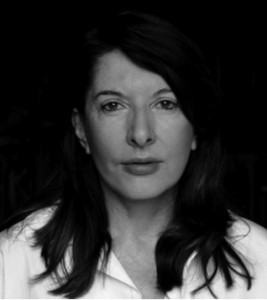
Marina Abramović (b.1946, Belgrade, Serbia)
Marina Abramović was born in 1946 in Belgrade, Yugoslavia. Her parents were Partisan war heroes who helped fight the Nazis in Earth State of war II and held high positions in the communist regime. Abramović's upbringing past her parents was extremely strict, enforcing a x pm curfew for Abramović into her twenties. She began her career in performance art in the early on 1970s, when she studied at the Academy of Fine Arts in Belgrade, and many of her early works were a course of rebellion to her oppressive communist upbringing. Abramović's desire for unrestricted expression of her mental and concrete self led her into increasingly conceptual work, gradually moving into sound installations before enacting her first operation piece, Rhythm x at the Edinburgh Festival in 1973. Over the next twelvemonth Abramović performed four more than pieces, in a series called Rhythms, in which she tested the psychological and physical limitations of her own trunk, besides as the consciousness of her audience.
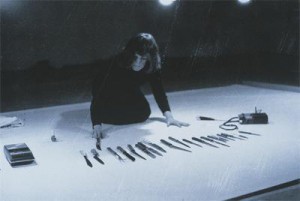
Over the by 40 years, Abramović has used her torso every bit a tool to test both concrete and emotional limits. At the same fourth dimension that Abramović explores her own concrete and psychological limitations, she besides challenges passive viewership. Abramović's performances are characterized by endurance and pain, too as by repetition, duration, and an emphasis on audition interaction.
Today Abramović is considered one of the most influential figures in the history of functioning fine art, and has been dubbed "the grandmother of performance fine art." She is currently in the process of opening her very ain Marina Abramović Found in Hudson, NY. At the MAI, Abramović's long-durational approach to operation (divers on the MAI website as 6 hours or more), called the Abramović Method, will be taught to the public in society to preserve the legacy of performance art. It is estimated to officially open in 2015. You can visit the official MAI website here.
(Marina Abramović of 1970s Presentation)

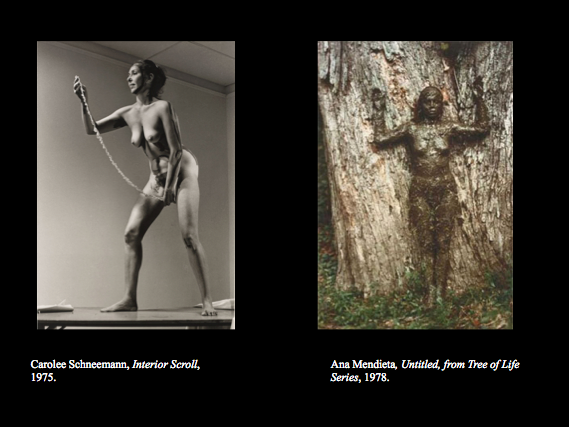

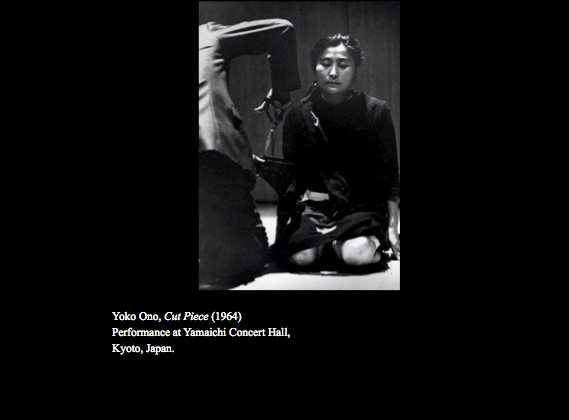
Rhythm x
1973
1 hour.
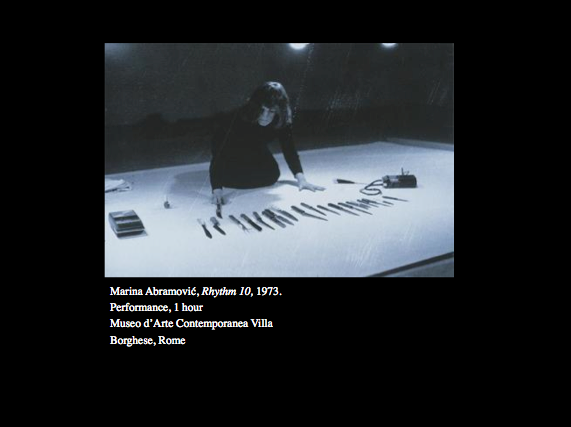

Rhythm 5
1974
1 1/ii hours.


Rhythm two
1974
7 hours.

Rhythm 4
1974
45 minutes.
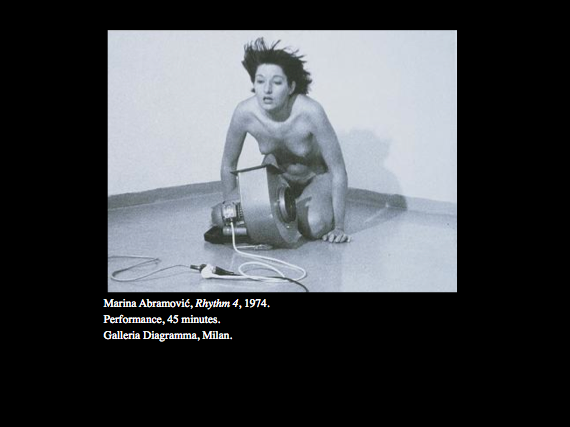
Rhythm 0
1974
6 Hours.
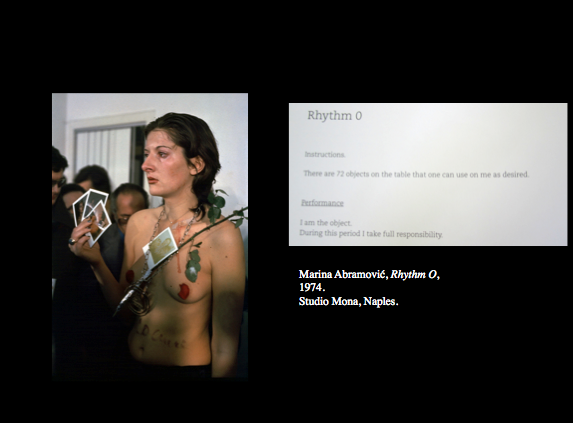

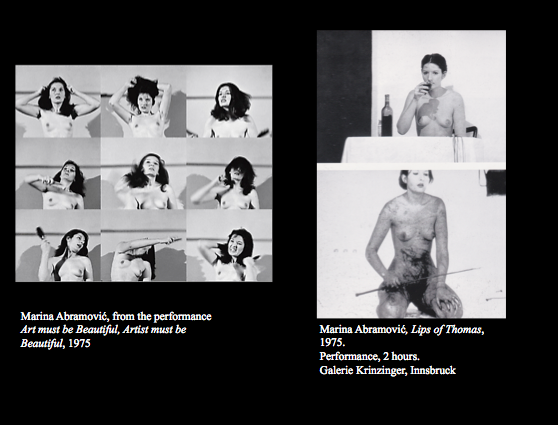
Ulay And Abramović:
Collaborative Performances


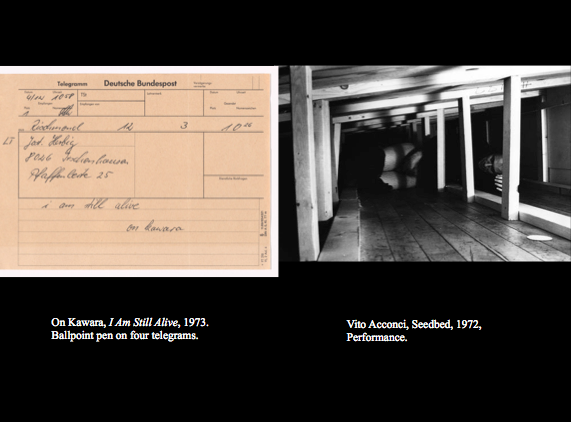

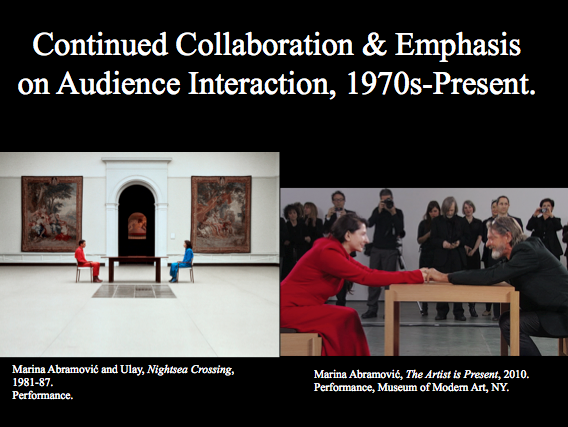
For more than information on the life and works of Marina Abramović, visit my Marina Abramović Youtube channel here.
Height 5 Video Picks:
1. In Your Confront: Interview: Marina Abramović:
This is a fascinating interview with Abramović. She talks about everything from her beginnings equally a performance creative person, her collaboration and relationship with swain artist Ulay, her celebrity collaborations, to her current performance works and upcoming Marina Abramović Establish. This is a wonderful video whether yous have only heard of Abramović, or you have studied her in depth and are interested her perspective on how she and her work has changed since the 1970s.
2. Marina and Ulay Archival:
In 1976 Abramovicć met German language artist Ulay, and for the next decade, until they dramatically parted ways in 1988, they collaborated in a serial of performance works where they presented themselves as a single, androgynous being called Ulay-Abramović. This was a determinative decade for Abramović, and in this video she discusses both her performance piece of work leading up to when she offset met Ulay, as well as the themes and ideas that developed during their time together. This video spans their unabridged relationship together leading up to Abramović's 2010 retrospective at MoMA, The Artist is Present, where Ulay made a surprise advent.
3. Body Art: Meet Performance Artist Marina Abramović:
While exist warned, this video is slightly corny (information technology is from an interview conducted for CBS Sun Morning), it does provide a nice overview of the life and work of Abramović, from her childhood in Belgrade, up to her present endeavors with the Marina Abramović Institute.
4.Marina Abramović: Embracing Way | "Exclusive" | Art21:
The premise of this video is a give-and-take with Abramović nigh her electric current honey of designer fashion, a fact that has earned her criticism from other artists and art critics as a sign of "selling out." Withal, this video past Art21 is much more than a discussion of manner. This video provides a great, concise overview of Abramović's early operation works of the 70s and 80s, including phenomenal video clips from the performances so that you don't need to rely solely on written descriptions of the works.
5. Marina Abramović: The Body every bit Medium:
For years Abramović studied drawing and painting, first at the institute in Belgrade, and and so in Zagreb, where she finally was exposed to performance. In this short video, Abramović talks about when she outset discovered the medium of performance and use of the body. It includes images of her early paintings, which were often of abstract clouds, voluptuous women, or car crashes.
Over the past twoscore years Marina Abramović has used her body as a tool to test both physical and emotional limits in her performances. At the same time that Abramović explores her own physical and psychological limitations, she is likewise challenging the traditionally passive function of viewer.
Below is a video which provides a useful overview of Abramović'southward career, from her outset in performance with the Rhythm Series in 1973, to her 2010 retrospective at the MoMA, The Creative person is Present.
The Confrontation of Sexual Difference: Ulay/Abramović
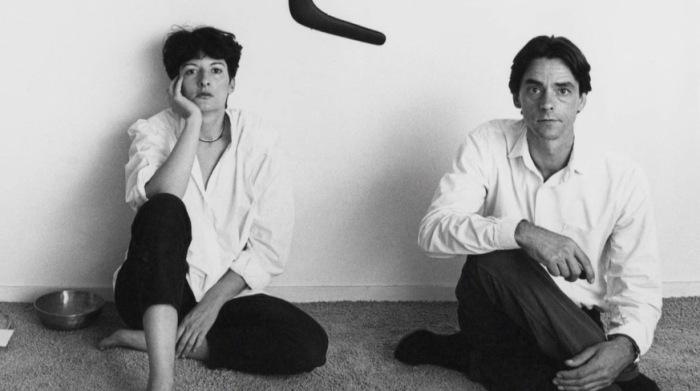
In 1976 Abramović met Westward-German artist, Ulay (Frank Uwe Laysiepen), and over the next decade Abramović and Ulay (Uwe Laysiepen) collaborated in a series of relational performances during which they referred to themselves every bit a commonage, androgynous beingness. In these collaborative works Abramović and Ulay questioned the socially defined identities of both femininity and masculinity, and encouraged viewers to participate through their ain exploration of gender relationships.
Relation in Time (1977)
In 1977 Abramović and Ulay performed Relation in Time in Bologna, Italy, where they sat back to back, tied together by their ponytails. Subsequently sixteen hours of sitting silent and barely moving, they allowed the public to enter the room and so that Abramović and Ulay could see if they could use the energy of the public to push their limits even further.
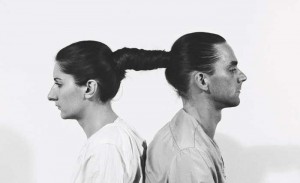
Below is a motion-picture show explaining the Registration in Fourth dimension functioning, along with video documentation of the piece.
Relation in Infinite (1976)
In Relation in Space (1976), Abramović and Ulay, both naked, repeatedly ran into each other at an increasing pace, until after an hour and a one-half they were smacking into one some other then difficult that Abramović was being thrown to the ground (image ii).
Imponderabilia (1977)
In Imponderabilia, Abramović and Ulay, stood every bit human doorposts on either side of the narrow archway to the museum. The narrowness of the space forced visitors to squeeze sideways betwixt them, having to choose whether to face the naked Ulay or naked Abramović (epitome 3). The focus of the performance is not to emphasize the vulnerability of the nude bodies of Abramović and Ulay, but rather the reactions of the visitors.
Beneath is video documentation of Imponderabilia.
Breathing In, Breathing Out (1977)
Animate In, Breathing Out was performed in 1977 in Belgrade. For this slice, which lasted 19 minutes, Abramović and Ulay plugged their noses with cigarette filters, then pressed their mouths together, passing their breath back and along for as long as possible (image 4). This piece, through the exchange of i breath, is representative of Abramović and Ulay's interest in presenting themselves as one, androgynous being.
Below is a 30 second clip from Breathing In, Animate Out:
AAA-AAA (1978)
In this operation Abramović and Ulay stand opposite of each other and brand long sounds with their mouths open up. Gradually, they move closer and closer to one another, until eventually they are yelling directly into each others open mouths (image five). The performance, which lasted 15 minutes, continued until both artist's voices were out of sync and failing from the continuous yelling. This slice demonstrates their involvement in endurance and duration, as well as an exploration of aggression between physically present figures, one male and one female.
Below is a ten-minute film explaining the performance AAA-AAA, including video documentation of the functioning.
Nightsea Crossing (1981-1987)
In Nightsea Crossing, a series of twenty-two performances betwixt 1981 and 1987. In these performances, Abramović and boyfriend creative person, Uwe Laysiepen, or Ulay, sat silently across from each other in chairs for seven hours a twenty-four hour period (epitome half dozen). Through this series of performances Abramović and Ulay attempted to portray the continuation of inner consciousness despite exterior motionlessness.
Source: https://blogs.uoregon.edu/marinaabramovic/category/uncategorized/